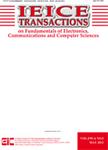版权所有:内蒙古大学图书馆 技术提供:维普资讯• 智图
内蒙古自治区呼和浩特市赛罕区大学西街235号 邮编: 010021

作者机构:Hokkaido Univ Grad Sch Engn Sapporo Hokkaido 0608628 Japan
出 版 物:《IEICE TRANSACTIONS ON FUNDAMENTALS OF ELECTRONICS COMMUNICATIONS AND COMPUTER SCIENCES》 (电子信息通信学会汇刊:电子学、通信及计算机科学基础)
年 卷 期:2000年第E83A卷第2期
页 面:371-379页
核心收录:
学科分类:0808[工学-电气工程] 0809[工学-电子科学与技术(可授工学、理学学位)] 08[工学] 0812[工学-计算机科学与技术(可授工学、理学学位)]
主 题:multi-agent system ant algorithm traveling salesman problems combinatorial optimization problems
摘 要:Recently, researchers in various fields have shown interest in the behavior of creatures from the viewpoint of adaptiveness and flexibility. Ants, known as social insects, exhibit collective behavior in performing tasks that can not be carried out by an individual ant. In ant colonies. chemical substances, called pheromones, are used as a way to communicate important information on global behavior. For example. ants looking for food lay the way back to their nest with a specific type of pheromone. Other ants can follow the pheromone trail and find their way to baits efficiently. In 1991, Colorni et al. proposed the ant algorithm for Traveling Salesman Problems (TSPs) by using the analogy of such foraging behavior and pheromone communication. In the ant algorithm, there is a colony consisting of many simple ant agents that continuously visit TSP cities with opinions to prefer subtours connecting near cities and they lay strong pheromones. The ants completing their tours lay pheromones of various intensities with passed subtours according to distances. Namely, subtours in TSP tourns that have the possibility of being better tend to have strong pheromones, so the ant agents specify good regions in the search space by using this positive feedback mechanism. In this paper, we propose a multiple ant colonies algorithm that has been extended from the ant algorithm. This algorithm as several ant colonies for solving a TSP, while the original has only a single ant colony. Moreover, two kinds of pheromone effects, positive and negative pheromone effects, are introduced as the colony-level interactions. As a result of colony-level interactions, the colonies can exchange good schemata for solving a problem and can maintain their own variation in the search process. The proposed algorithm shows better performance than the original algorithm with almost the same agent strategy used in both algorithms except for the introduction of colony-level interactions.